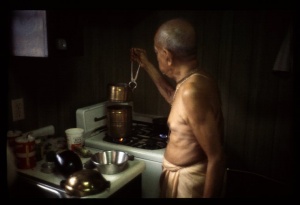CC Madhya 20.192: Difference between revisions
m (1 revision(s)) |
(Vanibot #0054 edit - transform synonyms into clickable links, which search similar occurrences) |
||
| (One intermediate revision by one other user not shown) | |||
| Line 1: | Line 1: | ||
{{ | [[Category:Sri Caitanya-caritamrta - Madhya-lila Chapter 20|C192]] | ||
<div style="float:left">'''[[Sri Caitanya-caritamrta|Śrī Caitanya-caritāmṛta]] - [[CC Madhya|Madhya-līlā]] - [[CC Madhya 20|Chapter 20: Lord Śrī Caitanya Mahāprabhu Instructs Sanātana Gosvāmī in the Science of the Absolute Truth]]'''</div> | |||
<div style="float:right">[[File:Go-previous.png|link=CC Madhya 20.191|Madhya-līlā 20.191]] '''[[CC Madhya 20.191|Madhya-līlā 20.191]] - [[CC Madhya 20.193|Madhya-līlā 20.193]]''' [[File:Go-next.png|link=CC Madhya 20.193|Madhya-līlā 20.193]]</div> | |||
{{CompareVersions|CC|Madhya 20.192|CC 1975|CC 1996}} | |||
{{RandomImage}} | |||
==== TEXT 192 ==== | ==== TEXT 192 ==== | ||
<div | <div class="verse"> | ||
punaḥ kṛṣṇa catur-vyūha lañā pūrva-rūpe | :punaḥ kṛṣṇa catur-vyūha lañā pūrva-rūpe | ||
paravyoma-madhye vaise nārāyaṇa-rūpe | :paravyoma-madhye vaise nārāyaṇa-rūpe | ||
</div> | </div> | ||
| Line 12: | Line 16: | ||
==== SYNONYMS ==== | ==== SYNONYMS ==== | ||
<div | <div class="synonyms"> | ||
''[//vanipedia.org/wiki/Special:VaniSearch?s=punaḥ&tab=syno_o&ds=1 punaḥ]'' — again; ''[//vanipedia.org/wiki/Special:VaniSearch?s=kṛṣṇa&tab=syno_o&ds=1 kṛṣṇa]'' — Kṛṣṇa; ''[//vanipedia.org/wiki/Special:VaniSearch?s=catur&tab=syno_o&ds=1 catur]-[//vanipedia.org/wiki/Special:VaniSearch?s=vyūha&tab=syno_o&ds=1 vyūha]'' — the quadruple expansions; ''[//vanipedia.org/wiki/Special:VaniSearch?s=lañā&tab=syno_o&ds=1 lañā]'' — taking; ''[//vanipedia.org/wiki/Special:VaniSearch?s=pūrva&tab=syno_o&ds=1 pūrva]-[//vanipedia.org/wiki/Special:VaniSearch?s=rūpe&tab=syno_o&ds=1 rūpe]'' — as previously; ''[//vanipedia.org/wiki/Special:VaniSearch?s=paravyoma&tab=syno_o&ds=1 paravyoma]-[//vanipedia.org/wiki/Special:VaniSearch?s=madhye&tab=syno_o&ds=1 madhye]'' — in the ''paravyoma'' area; ''[//vanipedia.org/wiki/Special:VaniSearch?s=vaise&tab=syno_o&ds=1 vaise]'' — resides; ''[//vanipedia.org/wiki/Special:VaniSearch?s=nārāyaṇa&tab=syno_o&ds=1 nārāyaṇa]-[//vanipedia.org/wiki/Special:VaniSearch?s=rūpe&tab=syno_o&ds=1 rūpe]'' — in the form of four-handed Nārāyaṇa. | |||
</div> | </div> | ||
| Line 19: | Line 23: | ||
==== TRANSLATION ==== | ==== TRANSLATION ==== | ||
<div | <div class="translation"> | ||
“Lord Kṛṣṇa again expands, and within the paravyoma, the spiritual sky, He is situated in fullness as the four-handed Nārāyaṇa, accompanied by expansions of the original quadruple form. | “Lord Kṛṣṇa again expands, and within the paravyoma, the spiritual sky, He is situated in fullness as the four-handed Nārāyaṇa, accompanied by expansions of the original quadruple form. | ||
</div> | </div> | ||
| Line 26: | Line 30: | ||
==== PURPORT ==== | ==== PURPORT ==== | ||
<div | <div class="purport"> | ||
At the top of the paravyoma, the spiritual sky, there is Goloka Vṛndāvana, which is divided into three parts. Two of the parts, called Mathurā and Dvārakā, are the residences of Kṛṣṇa in His prābhava-vilāsa forms. Balarāma, Kṛṣṇa’s vaibhava-prakāśa, is eternally situated in Gokula. From the quadruple prābhava-vilāsa, twenty-four forms of the vaibhava-vilāsa are expanded. Each has four hands holding weapons in different positions. The topmost planet in the spiritual sky is Goloka Vṛndāvana, and below that planet is the spiritual sky itself. In that spiritual sky, Kṛṣṇa Himself is four-handed and is situated as Nārāyaṇa. | At the top of the ''paravyoma'', the spiritual sky, there is Goloka Vṛndāvana, which is divided into three parts. Two of the parts, called Mathurā and Dvārakā, are the residences of Kṛṣṇa in His ''prābhava-vilāsa'' forms. Balarāma, Kṛṣṇa’s ''vaibhava-prakāśa'', is eternally situated in Gokula. From the quadruple ''prābhava-vilāsa'', twenty-four forms of the ''vaibhava-vilāsa'' are expanded. Each has four hands holding weapons in different positions. The topmost planet in the spiritual sky is Goloka Vṛndāvana, and below that planet is the spiritual sky itself. In that spiritual sky, Kṛṣṇa Himself is four-handed and is situated as Nārāyaṇa. | ||
</div> | </div> | ||
__NOTOC__ | |||
<div style="float:right; clear:both;">[[File:Go-previous.png|link=CC Madhya 20.191|Madhya-līlā 20.191]] '''[[CC Madhya 20.191|Madhya-līlā 20.191]] - [[CC Madhya 20.193|Madhya-līlā 20.193]]''' [[File:Go-next.png|link=CC Madhya 20.193|Madhya-līlā 20.193]]</div> | |||
__NOTOC__ | |||
__NOEDITSECTION__ | |||
Latest revision as of 22:38, 19 February 2024

A.C. Bhaktivedanta Swami Prabhupada
TEXT 192
- punaḥ kṛṣṇa catur-vyūha lañā pūrva-rūpe
- paravyoma-madhye vaise nārāyaṇa-rūpe
SYNONYMS
punaḥ — again; kṛṣṇa — Kṛṣṇa; catur-vyūha — the quadruple expansions; lañā — taking; pūrva-rūpe — as previously; paravyoma-madhye — in the paravyoma area; vaise — resides; nārāyaṇa-rūpe — in the form of four-handed Nārāyaṇa.
TRANSLATION
“Lord Kṛṣṇa again expands, and within the paravyoma, the spiritual sky, He is situated in fullness as the four-handed Nārāyaṇa, accompanied by expansions of the original quadruple form.
PURPORT
At the top of the paravyoma, the spiritual sky, there is Goloka Vṛndāvana, which is divided into three parts. Two of the parts, called Mathurā and Dvārakā, are the residences of Kṛṣṇa in His prābhava-vilāsa forms. Balarāma, Kṛṣṇa’s vaibhava-prakāśa, is eternally situated in Gokula. From the quadruple prābhava-vilāsa, twenty-four forms of the vaibhava-vilāsa are expanded. Each has four hands holding weapons in different positions. The topmost planet in the spiritual sky is Goloka Vṛndāvana, and below that planet is the spiritual sky itself. In that spiritual sky, Kṛṣṇa Himself is four-handed and is situated as Nārāyaṇa.